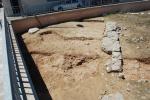Summary (English)
This was the fifteenth campaign at the Messapian settlement of Muro Leccese. As in previous years, excavation took place on the public land in the locality of Cunella, situated in the central-eastern part of the ancient site.
The investigations looked at two areas: the first (Fig. 1, Area A) in the courtyard of the residential Messapian building; the second (Fig. 2, Area B) in the south corner of the archaeological area where, over the course of preceding campaigns, a building cut both to the east and west by a modern road, was uncovered.
In Area A, last season’s excavation area was extended. The removal of a series of earth layers confirmed the absence of structures but also revealed a substantial amount of pottery from the Archaic phase (mid 6th-5th centuries B.C.), in particular the Iron Age. Among the Archaic finds were a fragment of a red-figure column crater, probably Attic, and numerous fragments of stone architectural elements. Most of the Iron Age material was constituted by impasto pottery and plain and matt-painted wares. As in other contexts excavated on the site, imported pottery datable to between the mid 8th century and the first half of the 6th century B.C. was rare; the best represented class being a filetti cups
The archaeological levels were removed down to the bedrock (Fig. 2), which was probably exposed during the Iron Age as archaeological materials were found resting directly on it.Area B is situated in the south corner of the locality of Cunella, in correspondence with a structure (room 10) partially cut by modern enclosure walls, and partly investigated in 2008. The structure had also been damaged by the robbing of its foundation blocks.
The excavation aimed to expose the foundation trenches and the floor in order to clarify the date of its construction. The excavations revealed a cobbled surface that partially continued below the foundation blocks and therefore predated the structure, which the pottery evidence attributes to between the 4th century B.C. and the bellum sallentium.Several test trenches placed parallel to the walls (Fig. 3) showed the cobbled surface to be extensive. It can be interpreted as an intervention to level the surface of the bedrock.
The total absence of diagnostic pottery makes it difficult to determine the date this cobble surface was laid. However, it may be suggested that the surface was part of work to prepare the area before the construction of the building, which in the light of the techniques and materials used, and the few pottery fragments recovered, can be dated to the late Hellenistic period.
- Francesco Meo - Università del Salento
Director
- Laura Masiello, Soprintendenza per i Beni Archeologici della Puglia
- Liliana Giardino - Università del Salento
Team
- Catia Bianco
- Teresa Oda Calvaruso
Research Body
- Soprintendenza per i Beni Archeologici della Puglia
- Università del Salento
Funding Body
- Università del Salento






![Download [PDF]](/excavation/skins/fasti/images/results/download_sml.png)

